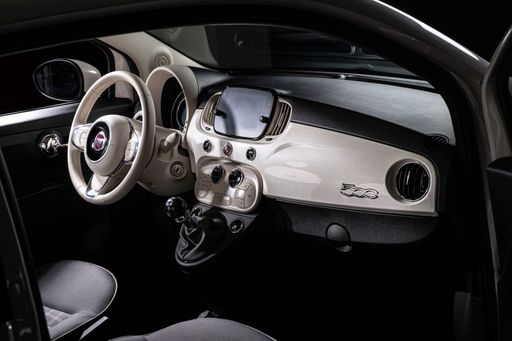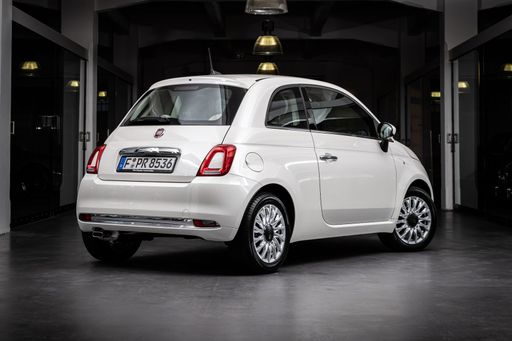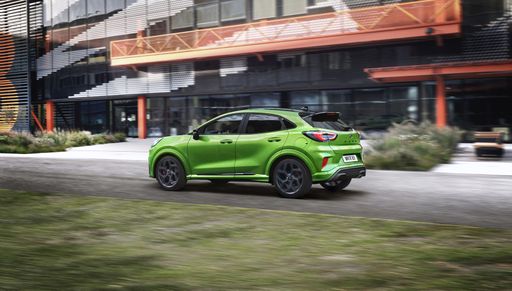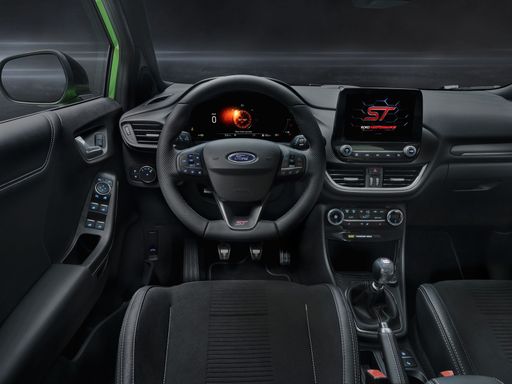Fiat 500 vs Ford Puma – Performance, range & efficiency compared
Both models have their strengths – but which one suits you more?
Compare performance, efficiency, price and space directly: Fiat 500 or Ford Puma?
Costs and Efficiency:
Price and efficiency are often the first things buyers look at. Here it becomes clear which model has the long-term edge – whether at the pump, the plug, or in purchase price.
Fiat 500 has a distinct advantage in terms of price – it starts at 18800 £, while the Ford Puma costs 24800 £. That’s a price difference of around 5923 £.
Fuel consumption also shows a difference: Fiat 500 manages with 5.30 L and is therefore minimal more efficient than the Ford Puma with 5.40 L. The difference is about 0.10 L per 100 km.
In terms of energy consumption, the advantage goes to the Fiat 500: with 13 kWh per 100 km, it’s slight more efficient than the Ford Puma with 13.10 kWh. That’s a difference of about 0.10 kWh.
As for range, the Ford Puma performs slightly better – achieving up to 376 km, about 45 km more than the Fiat 500.
Engine and Performance:
Power, torque and acceleration say a lot about how a car feels on the road. This is where you see which model delivers more driving dynamics.
When it comes to engine power, the Ford Puma has a evident edge – offering 168 HP compared to 118 HP. That’s roughly 50 HP more horsepower.
In acceleration from 0 to 100 km/h, the Ford Puma is distinct quicker – completing the sprint in 7.40 s, while the Fiat 500 takes 9 s. That’s about 1.60 s faster.
In terms of top speed, the Ford Puma performs distinct better – reaching 210 km/h, while the Fiat 500 tops out at 155 km/h. The difference is around 55 km/h.
There’s also a difference in torque: Ford Puma pulls clearly perceptible stronger with 290 Nm compared to 220 Nm. That’s about 70 Nm difference.
Space and Everyday Use:
Cabin size, boot volume and payload all play a role in everyday practicality. Here, comfort and flexibility make the difference.
Seats: Ford Puma offers somewhat more seating capacity – 5 vs 4.
In curb weight, Fiat 500 is to a small extent lighter – 1141 kg compared to 1316 kg. The difference is around 175 kg.
In terms of boot space, the Ford Puma offers clearly more room – 523 L compared to 185 L. That’s a difference of about 338 L.
In maximum load capacity, the Ford Puma performs decisively better – up to 1283 L, which is about 733 L more than the Fiat 500.
When it comes to payload, Ford Puma distinct takes the win – 469 kg compared to 325 kg. That’s a difference of about 144 kg.
Who comes out on top?
Overall, the Ford Puma shows itself to be leaves the rival little chance and secures the title of DriveDuel Champion.
It convinces with the more balanced overall package and proves to be the more versatile choice for everyday use.
 @ Ford Motor Company / Ford Media Center
@ Ford Motor Company / Ford Media Center
Ford Puma
Fiat 500
The Fiat 500 is a cheeky, retro‑styled city car that turns heads with its iconic looks and playful personality. Perfect for weaving through tight streets and easing into tiny parking spots, it’s aimed at buyers who want style and character more than grand touring prowess.
details @ Fiat / Stellantis Media
@ Fiat / Stellantis Media
 @ Fiat / Stellantis Media
@ Fiat / Stellantis Media
 @ Fiat / Stellantis Media
@ Fiat / Stellantis Media
Ford Puma
The Ford Puma is a cheeky compact crossover that blends sporty styling with city-friendly practicality, giving drivers a surprisingly fun and composed ride. With clever storage tricks and a lively personality, it’s a smart pick for buyers who want enjoyment without fuss.
details @ Ford Motor Company / Ford Media Center
@ Ford Motor Company / Ford Media Center
 @ Ford Motor Company / Ford Media Center
@ Ford Motor Company / Ford Media Center
 @ Ford Motor Company / Ford Media Center
@ Ford Motor Company / Ford Media Center
 @ Ford Motor Company / Ford Media Center
@ Ford Motor Company / Ford Media Center
 @ Fiat / Stellantis Media
@ Fiat / Stellantis Media
|
 @ Ford Motor Company / Ford Media Center
@ Ford Motor Company / Ford Media Center
|
|
|
|
Costs and Consumption |
|
|---|---|
|
Price
18800 - 30800 £
|
Price
24800 - 36300 £
|
|
Consumption L/100km
5.30 L
|
Consumption L/100km
5.4 - 5.9 L
|
|
Consumption kWh/100km
13 - 14.7 kWh
|
Consumption kWh/100km
13.1 - 13.9 kWh
|
|
Electric Range
190 - 331 km
|
Electric Range
361 - 376 km
|
|
Battery Capacity
21.3 - 37.3 kWh
|
Battery Capacity
43 kWh
|
|
co2
0 - 120 g/km
|
co2
0 - 135 g/km
|
|
Fuel tank capacity
-
|
Fuel tank capacity
42 L
|
Dimensions and Body |
|
|---|---|
|
Body Type
Hatchback
|
Body Type
SUV
|
|
Seats
4
|
Seats
5
|
|
Doors
3 - 4
|
Doors
5
|
|
Curb weight
1141 - 1475 kg
|
Curb weight
1316 - 1563 kg
|
|
Trunk capacity
183 - 185 L
|
Trunk capacity
456 - 523 L
|
|
Length
3631 - 3632 mm
|
Length
4186 - 4226 mm
|
|
Width
1683 - 1684 mm
|
Width
1805 mm
|
|
Height
1527 - 1532 mm
|
Height
1550 - 1555 mm
|
|
Max trunk capacity
440 - 550 L
|
Max trunk capacity
1216 - 1283 L
|
|
Payload
250 - 325 kg
|
Payload
367 - 469 kg
|
Engine and Performance |
|
|---|---|
|
Engine Type
Electric, Petrol MHEV
|
Engine Type
Electric, Petrol MHEV
|
|
Transmission
Automatic, Manuel
|
Transmission
Automatic, Manuel
|
|
Transmission Detail
Reduction Gearbox, Manual Gearbox
|
Transmission Detail
Reduction Gearbox, Manual Gearbox, Dual-Clutch Automatic
|
|
Drive Type
Front-Wheel Drive
|
Drive Type
Front-Wheel Drive
|
|
Power HP
65 - 118 HP
|
Power HP
125 - 168 HP
|
|
Acceleration 0-100km/h
9 - 16.2 s
|
Acceleration 0-100km/h
7.4 - 9.8 s
|
|
Max Speed
135 - 155 km/h
|
Max Speed
160 - 210 km/h
|
|
Torque
220 Nm
|
Torque
170 - 290 Nm
|
|
Number of Cylinders
3
|
Number of Cylinders
3
|
|
Power kW
48 - 87 kW
|
Power kW
92 - 124 kW
|
|
Engine capacity
999 cm3
|
Engine capacity
999 cm3
|
General |
|
|---|---|
|
Model Year
2023 - 2025
|
Model Year
2025
|
|
CO2 Efficiency Class
A, D
|
CO2 Efficiency Class
A, D
|
|
Brand
Fiat
|
Brand
Ford
|
What drivetrain options does the Fiat 500 have?
The Fiat 500 is offered with Front-Wheel Drive.
The prices and data displayed are estimates based on German list prices and may vary by country. This information is not legally binding.
